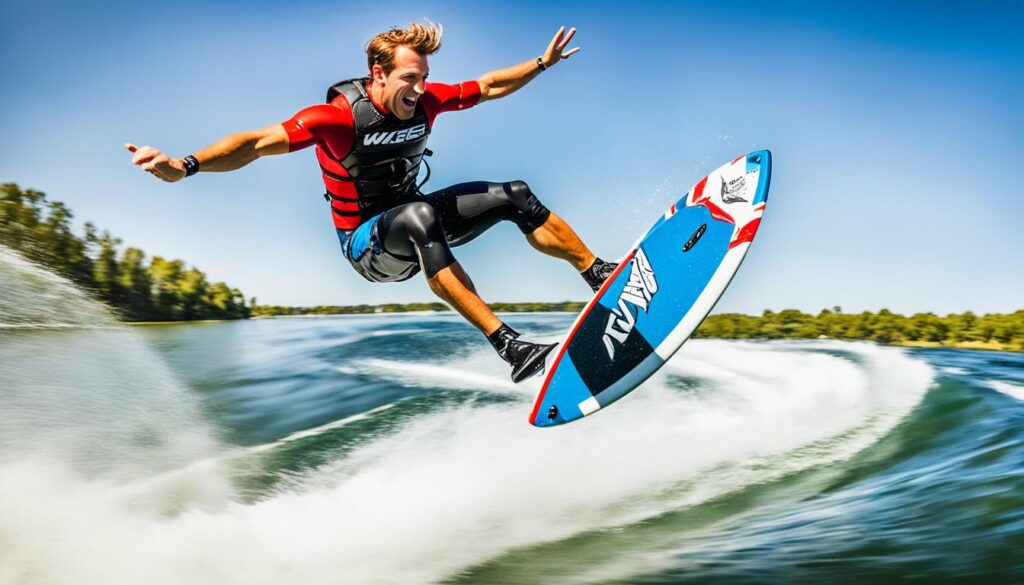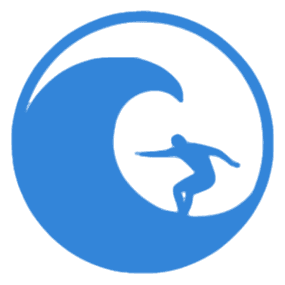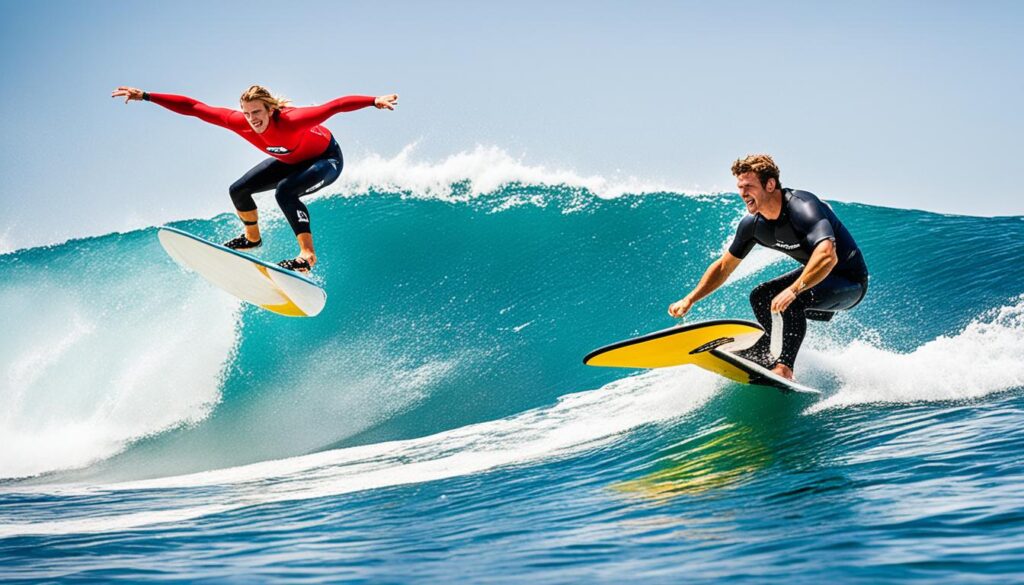When it comes to catching waves, there are two popular choices that often spark debate: traditional surfing and the newer sport of wakesurfing. But what exactly sets these two surf sports apart? Is one more thrilling than the other? Let’s dive into the world of water sports and explore the key differences between surfing and wakesurfing.
Key Takeaways:
- Wakeboarding and wakesurfing offer unique experiences for wave enthusiasts.
- Surfing allows you to ride ocean waves, while wakesurfing uses a boat’s wake.
- The sizes of surfboards and wakeboards differ due to different techniques and wave conditions.
- Stance, weight distribution, and foot movement play critical roles in both sports.
- Wakesurfing provides an opportunity for surfing enthusiasts to ride even in flat water and practice maneuvers.
Learning to Surf
When it comes to learning to surf, understanding the different surfboard types is key. Whether you’re diving into the world of traditional surfing or exploring the exhilarating sport of wake surfing, selecting the appropriate board is essential to your progress and enjoyment. Let’s dive into the differences between learning to surf and learning to wakesurf, and how surfboard types play a crucial role in each.
For those embarking on their surfing journey, beginners typically start with a longboard surfboard. These longer boards, typically ranging from 8 to 10 feet in length, offer stability and buoyancy, making it easier for learners to find their balance and catch waves. With their ample surface area, longboards provide a forgiving platform for beginners to practice their paddling, popping up, and riding techniques.
In contrast, wakesurfing employs a different approach. To get up on the wakesurfing board, the rider uses a ski rope attached to the boat. Once the rider is up and gliding, they can let go of the rope and maneuver on the wake created by the boat. The constant wake generated by the boat allows wakesurfers to utilize smaller surfboards than their ocean counterparts, typically ranging from 4’8″ to 5’6″ in length. These smaller boards offer increased maneuverability and responsiveness in the wake, allowing riders to perform tricks and turns with ease.
The table below provides an overview of the main differences between surfboards used for learning to surf and those used for learning to wakesurf:
| Surfboard Type | Learning to Surf | Learning to Wakesurf |
|---|---|---|
| Board Length | 8 to 10 feet (longboard) | 4’8″ to 5’6″ (smaller surfboard) |
| Board Stability | High stability for beginners | Increased maneuverability |
| Wave Catching | Easier wave-catching with larger board | Rider uses the boat’s wake |
| Learning Technique | Paddling, popping up, and riding techniques | Getting up on wake using ski rope |
Learning to surf and learning to wakesurf each present unique challenges and experiences. Whether you’re seeking the thrill of riding ocean waves or the excitement of wake-powered surfing, selecting the right surfboard type is crucial for your progression and enjoyment in these surf sports.
Stance and Weight Distribution
When it comes to wake surfing and surfing, the stance and weight distribution play a crucial role in controlling speed and maneuvering the board. Both sports have a preferred stance based on the rider’s natural foot placement, whether it be goofy or regular. In wake surfing, the rider stands sideways on the board with their lead foot forward, similar to regular surfing. This allows for better control and stability during the ride.
Weight distribution is another important aspect in both wake surfing and surfing. Putting more weight on the back foot slows down the ride, providing better control during turns and maneuvers. Conversely, leaning forward on the front foot increases speed and allows for more aggressive carving. However, it’s crucial not to lean too far in either direction, as this can lead to loss of balance and falling off the board. A balanced weight distribution and proper stance are key to successfully riding and maneuvering the waves.
Surfing Techniques
Mastering the art of surfing involves learning various techniques to navigate the waves effectively. In regular surfing, surfers rely on their balance, strength, and timing to catch waves and ride them. Paddling is an essential technique in regular surfing, as surfers use their arms to propel themselves forward and catch the waves. Once on the wave, they use their body weight and surfboard positioning to control their speed and direction.
On the other hand, wake surfing techniques differ slightly due to the constant wake generated by the boat. In wake surfing, the rider uses a tow rope initially to get up on the board and finds the sweet spot in the boat’s wake. Once in position, they let go of the rope and rely on their balance and board control to surf the wake. Body positioning, weight shifting, and subtle adjustments are used to maintain balance and control speed. Unlike regular surfing, wake surfing allows riders to continuously ride the wake as long as they maintain balance.
| Sport | Stance | Weight Distribution |
|---|---|---|
| Wake Surfing | Goofy or Regular | Back foot for control, forward foot for speed |
| Surfing | Goofy or Regular | Back foot for control, forward foot for speed |
Surfboard Size
When it comes to wake surfing, many riders are taken aback by the larger surfboards used in regular surfing. The reason behind this difference lies in the method of catching waves. Regular surfing requires paddling with your arms, which demands speed and energy, especially for beginners. Longer surfboards, such as longboards, offer faster paddling and better stability, making it easier for beginners to catch waves.
On the other hand, wake surfers enjoy the advantage of using a rope to get up on their boards and ride the boat’s wake. Once they’re up, they can let go of the rope and surf indefinitely as long as they maintain their balance. This eliminates the need for constant paddling found in regular surfing, allowing wake surfers to use smaller surfboards.
While larger surfboards aid in wave-catching, wake surfing enables riders to practice maneuvers even when the ocean is flat, providing a unique advantage. Let’s take a closer look at the surfboard types used in both wake surfing and regular surfing:
| Surfboard Type | Wake Surfing | Regular Surfing |
|---|---|---|
| Longboard | Not typically used | Mainly used by beginners for stability and easy wave-catching |
| Shortboard/Fish | Main surfboard choice | Used by more experienced surfers for maneuverability and performance in bigger waves |
| Funboard/Midsize | Used by surfers looking for a balance between stability and maneuverability | Offers versatility for various wave conditions |
As you can see, wake surfboards are generally smaller, allowing riders to make quick turns and perform stylish tricks on the boat’s wake. Regular surfboards, on the other hand, come in different sizes to suit a variety of wave conditions, catering to surfers’ specific needs based on their skill level.
Now that we understand the difference in surfboard size between wake surfing and regular surfing, the next section will focus on the benefits of wake surfing.
Benefits of Wake Surfing
Wake surfing offers numerous benefits, making it an attractive alternative to regular surfing. Whether you live far from coastal regions or simply want to enjoy wave-riding experiences in any location, wake surfing provides an exhilarating and accessible option.
One key advantage of wake surfing is that it eliminates the need for ocean waves. Instead, a boat generates a consistent and predictable wake, allowing riders to surf indefinitely. This unique feature provides experienced surfers with ample opportunities to practice maneuvers repeatedly, honing their skills and mastering new techniques.
“Wake surfing offers experienced surfers the chance to ride and practice maneuvers repeatedly, thanks to the consistent and predictable wake provided by the boat.”
Moreover, wake surfing isn’t limited to coastal areas with suitable surf conditions. It can be enjoyed even when the ocean is flat, commonly referred to as “flatwater surfing.” This versatility makes wake surfing an ideal choice for individuals who don’t have easy access to coastal regions but still want to experience the thrill of riding a wave.
Complementing its accessibility, wake surfing offers a range of practical benefits. The ability to surf without the need for natural waves allows riders to enjoy the sport on their own time and schedule. Additionally, wake surfing doesn’t depend on external factors such as tides or crowded surf breaks, providing a more consistent and hassle-free experience.
Ultimately, wake surfing provides a unique blend of excitement, accessibility, and versatility. Whether you’re an experienced surfer looking for a new practice ground or simply someone eager to ride the waves in any location, wake surfing promises endless fun and boundless opportunities for growth.

| Benefits of Wake Surfing | Advantages |
|---|---|
| Accessible | Experience wave-riding thrill without proximity to the ocean |
| Consistent | Boat-generated wakes provide predictable and repetitive surf conditions |
| Versatile | Enjoyable even when the ocean is flat, enabling flatwater surfing |
| Flexible | No reliance on tides or crowded surf breaks; surf on your schedule |
Differences in Gear and Rope Usage
Wakesurfing and wakeboarding may appear similar at first glance, with their use of boards and ropes, but there are significant differences that set them apart.
When it comes to gear, wakeboarders secure their feet to the board using boots or bindings, much like in snowboarding. This provides stability and control during tricks and jumps.
Wakeboarders use boots or bindings to secure their feet to the board, similar to snowboarding.
On the other hand, wakesurfers have the freedom to move their feet freely on the board, imitating the experience of traditional surfing. This allows for more dynamic footwork and maneuverability on the waves.
The type and size of the boards also differ between the two sports. Wakesurfing offers surf-style boards that are typically longer, providing better stability and control in the water. Skim-style boards, on the other hand, are shorter and more maneuverable, allowing riders to perform tricks with ease.
Unlike wakeboarding, where riders are required to hold onto the rope for the entire ride, wakesurfers can let go of the rope once they achieve balance. This allows for a more authentic surfing experience and the freedom to fully immerse themselves in the waves.
The length of the ropes used in wakesurfing and wakeboarding also varies. Wakesurfing ropes are typically shorter, ranging from 10 to 20 feet. This shorter length allows for better maneuverability and control on the water. In contrast, wakeboarding ropes are longer, ranging from 65 to 85 feet, providing riders with the length needed for jumps, tricks, and aerial maneuvers.
Here is a visual comparison of the gear differences between wakesurfing and wakeboarding:
| Aspect | Wakesurfing | Wakeboarding |
|---|---|---|
| Footwear | Feet move freely on the board | Boots or bindings secure feet to the board |
| Board Size | Longer surf-style boards for stability | Shorter boards for maneuverability |
| Rope Usage | Can let go of the rope after achieving balance | Constantly holding onto the rope |
| Rope Length | Shorter ropes for maneuverability | Longer ropes for jumps and tricks |
Boat and Boat Speed
When it comes to wakesurfing and wakeboarding, choosing the right boat and understanding the ideal boat speed are crucial factors. Let’s explore the wakesurfing boat requirements, boat speed, and how they differ for wakeboarding.
Wakesurfing Boat Requirements
For wakesurfing, it is essential to use an inboard or V-drive boat that has the propeller positioned underneath. This design minimizes the risk of accidents for riders, ensuring their safety while enjoying the sport.
Boat Speed for Wakeboarding and Wakesurfing
Wakeboarding and wakesurfing have different boat speed requirements due to the nature of each sport. When wakeboarding, the boat typically operates at speeds between 15 and 25 mph. This range creates a firm and stable wake, ideal for performing tricks and jumps.
On the other hand, wakesurfing is done at slower speeds of 10 to 14 mph. This lower speed allows riders to move forward without the need to hold onto the rope, giving them the freedom to focus solely on riding the wake. The slower boat speed also contributes to the creation of a longer and more mellow wave, perfect for wakesurfing maneuvers.
Different Boat Speeds, Different Board Styles
The choice of boat speed not only impacts the experience for wakeboarders and wakesurfers but also influences the performance of different board styles. Depending on the preferred riding style, wakesurf boards are designed to excel in varying boat speeds. Some wakesurf board styles, such as surf-style boards, are better suited for slower boat speeds, providing more control and maneuverability. Other board styles, like skim-style boards, may perform better at higher speeds.
“Choosing the right boat and understanding the optimal boat speed are key aspects of enjoying wakesurfing and wakeboarding to the fullest.”
When it comes to wakesurfing and wakeboarding, having a suitable boat and understanding the ideal boat speed ensures a thrilling and enjoyable experience for riders. The wakesurfing boat requirements, including an inboard or V-drive boat for safety, and the different boat speeds for wakeboarding and wakesurfing contribute to the unique characteristics of each sport.
Ease and Enjoyment
When it comes to wakeboarding and wakesurfing, each sport offers its own unique blend of ease and enjoyment. While wakeboarding is often considered easier due to the secure footing and the simplicity of holding onto the rope while performing jumps and tricks, wakesurfing requires a different level of balance and foot movement since riders are not strapped into boots.
Despite the differences in difficulty, the enjoyment of wakeboarding and wakesurfing ultimately comes down to personal preference. Wakeboarding offers the adrenaline rush of high jumps and gravity-defying tricks, providing an exhilarating experience for those seeking an adrenaline-packed adventure on the water. The thrill of catching air and mastering complex maneuvers can be incredibly rewarding for wakeboarders.
On the other hand, wakesurfing provides a different kind of enjoyment. This sport grants riders the freedom to ride without the need to hold onto the rope, allowing them to fully immerse themselves in the waves. Wakesurfers can let go and ride the boat’s wake endlessly, harnessing the energy of the water to perform stylish turns and twists. The seamless flow and fluidity of wakesurfing create a captivating and rhythmic experience, perfect for riders who appreciate the artistry and grace of wave-riding.
Ultimately, whether you prefer the exciting jumps and tricks of wakeboarding or the smooth, surf-inspired maneuvers of wakesurfing, both sports offer a unique combination of ease and enjoyment. The choice between the two is a matter of personal preference and the desired kind of experience on the water.
Wakeboarding vs. Wakesurfing: A Comparison of Ease and Enjoyment
When considering the ease and enjoyment of wakeboarding and wakesurfing, it’s helpful to compare the key elements of each sport:
| Wakeboarding | Wakesurfing | |
|---|---|---|
| Difficulty | Easier due to secure footing and holding onto rope | Requires balance and foot movement without boots |
| Thrills | High jumps and tricks | Stylish turns and twists, riding endless wakes |
| Freedom | Performing tricks while holding onto the rope | Riding without the need to hold onto the rope |
| Experience | Adrenaline-packed adventure | Rhythmic and fluid wave-riding |
Tips for Improvement
To improve your wakeboarding skills and enhance your wakesurfing abilities, practice and dedication are key. Observing professionals in both sports and implementing specific techniques can significantly elevate your performance. Whether you’re aiming to perfect wakeboarding tricks or achieve better balance and foot movement on a wakesurfing board, honing your skills requires commitment.
For wakeboarding, mastering riding with boots and performing aerial tricks is fundamental. By studying professionals and understanding their techniques, you can learn valuable insights that will elevate your wakeboarding abilities. Practice regularly, focusing on refining your skills and pushing your limits to enhance your performance on the water.
On the other hand, wakesurfing requires a strong sense of balance and precise foot movements on the board. As a beginner, seeking professional guidance is highly recommended. Learn from experienced wakesurfers who can teach you proper techniques and provide valuable tips to help you progress. Practice consistently and challenge yourself with different maneuvers to improve your wakesurfing skills over time.
Keep in mind that both wakeboarding and wakesurfing are sports that require time and patience to master. Don’t be discouraged by initial difficulties—persevere and stay determined. By investing in your training and learning from experts, you’ll find yourself steadily improving and achieving your goals in both wakeboarding and wakesurfing.

